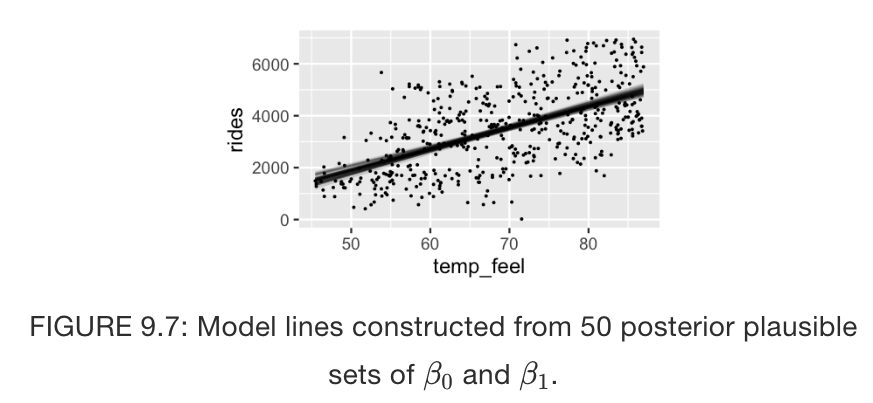9.6 Interpreting the posterior
What we have is samples of each of the parameters.
# Posterior summary statistics
broom.mixed::tidy(bike_model, # it takes our output from rstanarm::stan_glm
# fixed is regression coef
# aux is auxiliary, i.e. sigma
effects = c("fixed", "aux"),
conf.int = TRUE, conf.level = 0.80)
# A tibble: 4 x 5
term estimate std.error conf.low conf.high
<chr> <dbl> <dbl> <dbl> <dbl>
1 (Intercept) -2194. 362. -2656. -1732.
2 temp_feel 82.2 5.15 75.6 88.8
3 sigma 1281. 40.7 1231. 1336.
4 mean_PPD 3487. 80.4 3385. 3591. Here we can get the posterior median relationship :
\[ -2194.24 + 82.16X \] If we want a bigger picture:
# Store the 4 chains for each parameter in 1 data frame
bike_model_df <- as.data.frame(bike_model)
# Check it out
nrow(bike_model_df)
[1] 20000
head(bike_model_df, 3)
(Intercept) temp_feel sigma
1 -2657 88.16 1323
2 -2188 83.01 1323
3 -1984 81.54 1363
# 50 simulated model lines
bikes %>%
tidybayes::add_fitted_draws(bike_model, n = 50) %>%
ggplot(aes(x = temp_feel, y = rides)) +
geom_line(aes(y = .value, group = .draw), alpha = 0.15) +
geom_point(data = bikes, size = 0.05)
# [code not executed for run-time consideration]
Figure 9.7
Quiz: Do we have ample posterior evidence that there’s a positive association between ridership and temperature ?
Answer:
Visual evidence : 50 or more posterior scenarios that display positive relationship
Numerical evidence from credible interval:
- 80% CI for \(\beta_{1}\) range from 75.6 to 88.8
Numerical evidence from posterior probability
# Tabulate the beta_1 values that exceed 0
bike_model_df %>%
mutate(exceeds_0 = temp_feel > 0) %>%
tabyl(exceeds_0)
# imitate hypothesis test (null: coefficient = 0)
exceeds_0 n percent
TRUE 20000 100